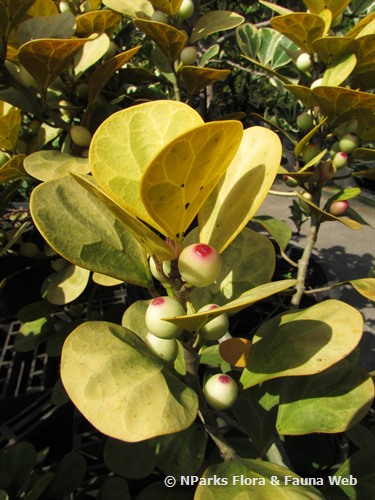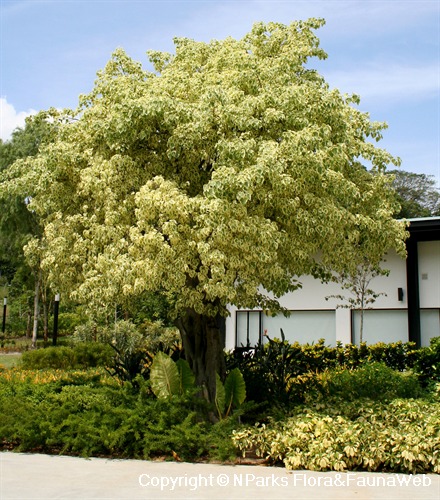
Name
Classifications and Characteristics
| Plant Division | Angiosperms (Flowering Seed Plants) |
|---|---|
| Plant Growth Form | Tree |
| Mode of Nutrition | Autotrophic |
| Maximum Height | 15 m |
Biogeography
| Native Distribution | Sri Lanka to India, S China, Andaman Islands, Australia (Queensland), and Malesia |
|---|---|
| Native Habitat | Terrestrial |
| Preferred Climate Zone | Tropical |
Description and Ethnobotany
| Growth Form | Ficus hispida is a shrub or tree up to 15 m tall. |
|---|---|
| Foliage | Branches are covered in brownish to whitish hairs. Petiole (1 – 14 cm long) usually have pairs of waxy glands at the nodes of the base. Epidermis of branches and petiole are often peeling. Leaves are mostly oppositely or sub-oppositely arranged, and can be spirally arranged. They are oblong to elliptic (5 – 35 cm long and 2.5 – 16 cm wide) with acuminate apex, cuneate to heart-shaped base and toothed margin. It has 4 – 10 pairs of lateral veins, and small waxy glands can be found on the middle lateral veins’ axis. Cystoliths are present on the underside of the leaves. |
| Fruit | Figs can occurs axillary or in bunches on slender shoots coming from the tree trunk. These shoots can be up to 1.5 m long. Fig is almost round (1.5 – 2.5 cm diameter) and turns from green to yellow as it ripens. Peduncle is 0.5 –3.5 cm long) and 3 basal bracts are present. |
| Habitat | It grows along rivers and forest edges. |
| Associated Fauna | Figs are pollinated by Ceratosolen solmsi marchali and observed to be dispersed by lesser short-nosed fruit bat (Cynopterus brachyotis), greater short-nosed fruit bat (Cynopterus sphinx), and Leschenault’s rousette (Rousettus leschenaultii) |
| Ethnobotanical Uses | Others: It is cultivated in India for its medicinal properties such as antidiarrheal purpose. In Nepal, it is used as food fodder for animals, while in Thailand, the rough leaves are used to scraping off eel’s sticky texture before cooking. |
Fauna, Pollination and Dispersal
| Pollination Method(s) | Biotic (Fauna) |
|---|---|
| Seed or Spore Dispersal | Biotic (Fauna) |
Plant Care and Propagation
| Light Preference | Full Sun, Semi-Shade |
|---|---|
| Water Preference | Moderate Water |
| Plant Growth Rate | Fast to Moderate |
Foliar
| Mature Foliage Colour(s) | Green |
|---|---|
| Mature Foliage Texture(s) | Papery |
Fruit, Seed and Spore
| Mature Fruit Colour(s) | Yellow / Golden |
|---|
References
| References | Berg, C. C. & E. J. H. Corner. 2005. Ficus subgenus Ficus. Flora Malesiana, Series I. 17(2): 71–136 Corner, E.J.H. 1988. Wayside Trees of Malaya Volume 1 & 2. Kuala Lumpur, Malaysia: The Malayan Nature Society. 861 Kochummen, K. M. & R. Go. 2000. Moraceae. Tree Flora of Sabah and Sarawak. 3: 181–334 |
|---|
Image Repository
Others
| Master ID | 33648 |
|---|---|
| Species ID | 8062 |
| Flora Disclaimer | The information in this website has been compiled from reliable sources, such as reference works on medicinal plants. It is not a substitute for medical advice or treatment and NParks does not purport to provide any medical advice. Readers should always consult his/her physician before using or consuming a plant for medicinal purposes. |






